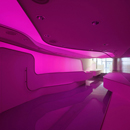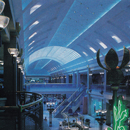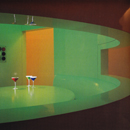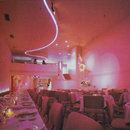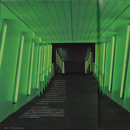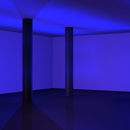
color flood
Color Flood describes the practice of filling a volume of space with highly saturated colored light. The space, planes, furnishings and occupants become imbued with the hue of light. more
color flood | Light
research
Blue Moon is a subset of Color Flood, and Color Flood could also be a Red Room if it is achieved with red light.
Effect
Color Flood affects and defines a volume of space. It colorizes everything in a space, including the occupants; Color Flood appears as one color per space, homogenizing the space.
Applications of Color Flood could be seen as an interpretation of several archetypical practices identified in a number of practice types - Blue Moon (resort and spa); Monochromatic Room (boutique hotel) and Red Room (art museum, restaurant).1 Color Flood transforms a White Box (art museum, retail) or a White Out (resort and spa, restaurant) space into a monochromatic one, such as Blue Moon and Red Room.2 The relationship between these Intypes gives rise to shared attributes among them.
The effect of Color Flood is achieved with color light rather than surface paint. Color Flood creates a glowing monochromatic space. In most instances, the colored light is diffused and even, eliminating shadows and flattening the visual scene. The colored light imposed upon the whole space further reduces color and tonal contrasts, and thus, obscures formal definition.
The overwhelming amount of color in a Color Flood renders everything in space, including the occupants, in the same hue, giving them an unusual, possibly surreal appearance. The more saturated the color, the greater the impact, as saturated colors have more density and strength, and thus are more stimulating.3 Color Flood can imbue the space with vibrancy not achievable by paint, because the brightness and saturation of colors is dependent on light.
Color cannot exist if it is not in the light source.4 Color that we see is determined by the color of reflected light, which in turn is affected by the color of the surface, the color of the light, and the quantity of light the surface receives. A surface of a certain color reflects only a portion of the waves in a light spectrum that adds up to give the color we see.5 Alternately, the range of light waves present in the incident light limits the reflectable light in the first place.
For instance, a red wall appears red under full spectrum white sunlight, because it reflects the red portion of the light spectrum and absorbs the rest. If light without the red portion of the spectrum hits the same red surface, since little or no light will be reflected, the surface will appear dark and devoid of color. This is most evidently seen in light artist Olalfur Eliasson's "Room for One Color" (2007).6
On the other hand, red light hitting a red surface of the room not only is reflected to reveal the color red, but the lack of other parts of the light spectrum purifies the reflected color and renders the surfaces more vibrant. Moreover, the quantity of light determines the quantity of reflected color, and hence the brightness of the color.7 A lack of light darkens color, while an addition of light intensifies color.8 Color Flood inherently adds light to a space, and therefore, can instill the space with vibrancy not achievable by paint alone. To achieve a strong impact in Color Flood, maximum color reflection can be facilitated by spatial elements that are colors of high value or have similar hues to the colored light.
The impact of Color Flood also varies by the color and context. Architectural theorist Thomas Thiis-Evensen posits that colors alter perceptions of weight, size and temperature. Furthermore, individual personal and cultural color associations, vary widely. Nonetheless the scope and intensity created by Color Flood magnifies a spatial experience.9
Chronological Sequence
Colored light was previously produced by filtering white light. Artificial colored light has rarely been used as permanent interior lighting since having sufficient light itself is a relatively recent development. Some of the early instances of artificial colored light occurred in the theatre and similar entertainment venues, where colored light contributed to heighten dramatic spatial impacts.
Light Art in the 1960 Decade
Several developments in the 1960 decade contributed to the increased interest and experimentation with light and color in interiors. These included 1) the growing influence of theatre lighting professionals who gradually introduced the concept of qualitative lighting design and the use of colored light to the industry; 2) the expansion of light art in the 1960s; and 3) the popularity of discotheques that became an experimental ground for multi-media experiences that made wide use of colored light. To some art critics, the multi-media experiments at the discos are extensions of the 1920s explorations in colored light performances.10
The visual art development called Light Art increased the awareness of light as a new modern material for expression. Several major exhibitions in the 1960s, most notably the Kunst Licht Kunst exhibition (1966) held in the Stedelijk Van Abbemuseum in the Netherlands, helped establish Light Art as a field in the fine arts. Many artists explored colored light in their works. The larger works led to installations that affected their surroundings while others consciously included such interactions as part of the work. Some of the most notable light artists during the subsequent decades made their start in the 1960s including Dan Flavin, James Turrell and Bruce Numann. Of the three, James Turrell produced several works composed of carefully defined Color Flood volumes. These environments served as inspiration to at least one, and perhaps more of the Color Flood applications later.11
Interior Design Applications in the 1960 and 1970 Decades
Experience-oriented spaces such as 1960-era discotheques and nightclubs in the United States became prime experimental grounds for multi-media experiences. Colored light enhanced the dancing experience at clubs such as Whisky A Go-Go (1966) on Sunset Strip in Los Angeles, California. The Electric Circus nightclub in New York City (1968) may be the first example of Color Flood. Artist Andy Warhol and an interdisciplinary group of designers installed theatrical lights in vibrant shades of amber. Dancers and the audience became imbued with the color. The Electric Circus' interior was also shaped by stretched fabric that became projection screens; color light bounced off this surface to color the entire space.
In addition to discotheques, entertainment interiors such as cabarets, clubs, bars and restaurants became experimental playgrounds for more theatrical lighting. These places did not require high ambient light levels, and dramatic colored lighting improved the overall experience. The Caesar Palace (1973) in Tokyo, Japan offered a restaurant and dance setting entirely lit in red.12 In the 1970 decade, colored light was used both in single and multiple colors. At the end of the 1970 decade, counter forces attacking the disco culture and its associated drug use brought this type to a relatively abrupt end. This change brought about a very cautious attitude towards colored lighting.
The 1980 Decade
From 1979 to the mid-1980s, occasional applications of colored light were primarily restricted to one color. Neon and colored fluorescents, cost-effective ways to colorize a space, were utilized in the Wings Restaurant (1982). An 85-feet-long curved pink neon tube served as the primary form of illumination in the restaurant. Like the Caesar Palace, in which amber-toned colored lights flattered people's skin tones, Wings' use of pink was believed to "soothe the soul".13 Certainly the pink light created a different spatial experience, and the economical lighting solution responded to the concerns about energy conservation.
The 1990 to 2010 Decades
In the 1990 decade lighting as creative expression expanded beyond restaurants to become popular in retail, showrooms and some workplaces. Examples of Color Flood from 1987 through the 2010 period called on light artists as significant collaborators with interior designers and architects.
Color Flood was used in large quasi-public spaces, such as the Forest Fair Mall in Cincinnati (1991). The addition of exceptionally large colored light installations in malls not only created greater visual impact, but also colorized both the architecture and the people in it, making monotonous interiors into a spectacle that marketers believed would attract more customers. Without any outside references, Color Flood suspended people in a timeless environment. be suspended in a timeless space.
Some of the most stunning examples of Color Flood during this period occurred in long pedestrian corridors, such as concourses between airline terminals and city underground passages. These long passageways offered new occasions for color light and light art installations. In airports, colored light installations combined with acoustical accompaniments; the installations were thought to diminish perceived travel time, often in underground facilities without any natural lighting.
Although the 1987 installation of changing multi-colored lights on the ceiling and walls in the Chicago O'Hare Airport, United Concourse B & C, is credited to Murphy/Jahn, but ground-breaking as it was, the design was not yet a Color Flood. Color Flood was first achieved in the McNamara Terminal in the Detroit Metropolitan Airport (2002). The SmithGroup created a colored light spectacle using an installation of LED fixtures, synchronized with music played in the tunnel.14 A Color Flood is achieved when the tunnel becomes imbued with one color at a time. The music-synchronized color changes (blue, green, purple, red) introduced different color environments to the pedestrian and generated a varied rhythm along the corridor. In addition to monochromatic schemes, polychromatic effects corresponding with music provided less coloration on pedestrians. The monochromatic Color Flood only occurred as moments of a larger performance.
In Oklahoma City, Elliot + Associates used museum-like white walls flooded with color-gelled fluorescent lights to replace the raw concrete walls and 1970's-style painted supergraphics.15 The colors served as a navigational tool. For example, green passages connected banks, and magenta led to hotels.16 These were further punctuated by white spaces that displayed historic black and white photos of the city.
From 1990 to 2010, the gradual entry of ultra-bright LEDs in interior architectural use renewed awareness about the potential of color light. Growth in color light applications also brought about breakthroughs in lighting and control systems technology that allowed more control over light in terms of color, the evenness of distribution, the shape and size of installation and the adjacent space needed for accessories. Richer colors, and a wider range of colors from ultra-bright LEDs were achieved by mixing red, green and the newer blue lights at various levels. In addition to amber tones favored in food and beverage interiors, aquariums tapped into blue light sources resulting from a combination of natural light filtered through depths of water, reflected blue light from blue walls and artificial blue light used as an enhancement.
Spas and health related recreational facilities also use blue light, because of the color's association with water, contributing to an archetypical practice called Blue Moon.17 In the Barton Gym (1995) in Chicago, the passage to the men's shower room was flooded in blue light to symbolize water and to distinguish the space from others. In comparison, the steam room in Bath Spa (2004) revealed denser and richer shades of aqua and deep blues.18
Other examples associated blue light with the sky and with technology. Drawing inspiration from the numerous forms of blue light, including the "ubiquitous glow of the monitor in the information age", the blue of water and sky, as well as light artist James Turrell's blue light spaces, MJP Architects flooded large sections of the Wellcome Center of Science with blue light from the peripheral walls.19
Until the late 1990 decade the prominent colors used for Color Flood were reds or blues. Green light was rarely found in fixed installations, because it was not a flattering color on skin. Philippe Starck, however, broke with this notion when he designed St. Martins Lane Hotel (2000) as an interactive space. Green was among a choice of colors that guests could choose to Color Flood their rooms. Personalizing one's hotel room became a feature of a number of boutique hotels during this period, like St. Martin's Lane; color and light soon became one of the options allowing guests to "paint [their] mood[s]."20 A similar lighting option was provided for the private dining room in Philadelphia restaurant POD. (2001) This new capability was initially made possible by specially developed digital control systems.
LEDs offered color variety previously unconsidered. Hospitality designers for Las Vegas clubs, hotels, restaurants and retail store designers embraced the vibrant exotic colors of light. In the Fornarina Store (2005), a white interior became a Color Flood by a deep fuchsia "sunset" emanating from LED-lit structures-a demonstration that appeared only ten minutes each day.21 The short time period in which the store's signature fuchsia lasted was a branding strategy that did not interfere with shopping. Various pre-programmed colors, such as those used in the MacNamara terminal, were also produced by mixing lights from variously colored LEDs. This technique was used for the lobby of Fornari Headquarters in Milan (2008).22
Exhibiting a similar concept of versatility on a much larger scale, the 120-feet-high lantern wall in the atrium space of Creative Artists Agency (2008) was backlit by metal halides with software-controlled dichroic filters.23 In this example, white or colored lights of softer tones offer a comparison with the saturated colors of entertainment environments. The Creative Artists Agency chose a subdued palette without sacrificing professionalism desired in the large corporate office.
Historic preservation projects, such as the ten-year renovation of the 1905 Musée des Arts Decoratifs in Paris (2007) embraced new technology to heighten spatial experience. The new chandeliers constructed of bands of hand-frosted PVC and lit by LEDs "can be programmed for 10,000 individual colors and color combinations." They are set to flood the hall with colored light relating to the time of the day, addressing the dimension of the passage of time in the interior.24 Color Flood gave the space a vibrant light that was impossible when the building was new. Furthermore, the indirect monochromatic light diminishes the contrasts created by shadows and color differences, flattens and de-emphasizes the appearance of ornate architectural elements and brings it closer to the simplicity of modernist architecture. Without the need to make large permanent alterations to the original building, Color Flood bridged the past to the present without sacrificing the interior's architectural integrity. The project may prove to be a model of other preservations efforts.
Summary
Through the 2000 to 2010 decade, LEDs prompted a new interest in evenly lit surfaces, giving rise to more examples of Color Flood. Color-changing became a convenient option for LED applications where colors were created by mixing different intensities of various colored LEDs; Color Flood is an effect derived from these installations. As illustrated in the Fornari Headquarters in Milan, the saturation and brightness of the colored light affect its ability to colorize objects within the environment. With less saturated colors or low brightness, the color lights can easily be washed out by other forms of ambient light. Although the convenient color-changing option allowed environments in various practice types to use Color Flood, it also reduced the commitment to permanent Color Flood to solve practical activity needs. All in all, Color Flood is growing in popularity, and more and more, it is becoming a temporal effect.
end notes
- 1) Rachel Joy Goldfarb, "Theory Studies: Archetypical Practices of Contemporary Resort and Spa Design" (MA Thesis, Cornell University, 2008), 54-55; Mijin Juliet Yang, "Theory Studies: Contemporary Boutique Hotel Design" (MA Thesis, Cornell University, 2005), 92-93; Joori Suh, "Theory Briefs: Contemporary Interior Design in Museums and Exhibition Spaces" (MA Thesis, Cornell University, 2004), 96; Soomin Jasmin Cho, "Restaurant Intypes: Contempraory Interior Design and Theory Study" (MA Thesis, Cornell University, 2009), 34.
- 2) Leah Maureen Scolere, "Theory Studies: Contemporary Retail Design" (MA Thesis, Cornell University, 2004), 32; Goldfarb, "Theory Studies: Archetypical Practices of Contemporary Resort and Spa Design," 54-55, 61-64.
- 3) Thomas Thiis-Evensen, Archetypes in Architecture (Oslo: Norwegian University Press, 1987), 245.
- 4) Robert F Ladau, Brent K. Smith and Jennifer Place, Color in Interior Design and Architecture (New York: Van Nostrand Reinhold, 1989), 58.
- 5) Ladau, Smith, Place, Color in Interior Design, 54.
- 6) "Room for One Color" [1997] Olafur Eliasson; Take Your Time Exhibition, Museum of Modern Art, New York City; PhotoCrd: Teri Duerr, NY Art Beat. http://www.nyartbeat.com/nyablog/2008/06/thanks-for-taking-the-time/ (accessed Aug. 8, 2009)
- 7) Ladau, Smith, Place, Color in Interior Design, 59.
- 8) Ladau, Smith, Place, Color in Interior Design, 59.
- 9) Thomas Thiis-Evensen, 248 from Faber Birren, Color Psychology and Color Therapy: A Factual Study of the Influence of Color on Human Life (New York: McGraw-Hill, 1950), 109; Ladau, Smith, Place, Color in Interior Design, 69-71.
- 10) Weibel, "The Development of Light Art," Light Art, 206-224. In Peter Weibal's essay on the development of light art, he discussed the multi-media experiments in the 1960s to be derived from the aims to unite music and visual arts through light. The development of electronic music and video led to the growth of synthetic sounds and images, combined in multi-media experiments.
- 11) Sara Hart,"Lighting and Building Technology Combine to Make a Perfect Match," Architectural Record 189, no. 1 (Jan. 2001), 64-65.
- 12) Anonymous, "Caesar's Palace," Architectural Record 104, no. 2 (Aug. 1973): 104; PhotoCrd: Eizaburo Hara.
- 13) Monica Geran,"In the Pink," Interior Design 53, no. 7 (Jul. 1982): 169.
- 14) Nayana Currimbhoy, "Light Waves: Tropical Colors, the Sounds of the Everglades, and Intense Light Enliven an Airport Concourse," Architectural Record 183, no.11 (Nov. 1995), Lighting Supplement: 22.
- 15) Edie Cohen, "The Way Forward," Interior Design 78, no. 10 (Aug. 2007): 196.
- 16) Cohen, "The Way Forward," 198.
- 17) Goldfarb, "Theory Studies, 54-55.
- 18) Henry Urbach, "Aero Studios," Interior Design 67, no. 1 (Jan. 1996): 88; Hugh Pearman, "Bath Spa, Bath, England," Architectural Record 192, no. 2 (Feb. 2004): 119.
- 19) Anonymous,"Art and Lighting Mesh in Lobbies of High-Tech Bank Facility," Architectural Record 182, no.11 (Nov. 1994), Record Lighting: 8; Sara Hart, "Lighting and Building Technology Combine to Make a Perfect Match," Architectural Record 189, no. 1 (Jan. 2001): 64.
- 20) Melissa Barrett Rhodes, "Room with a Hue," Interior Design 71, no. 1 (Jan. 2000): 130.
- 21) Suzanne Stephens, "Fornarina, Las Vegas, Nevada," Architectural Record 193, no. 2 (Feb. 2005): 140.
- 22) Craig Kellogg, "Leaving Las Vegas," Interior Design 80, no. 7 (May. 2009): 156.
- 23) Edie Cohen, "Stairways to the Stars," Interior Design 78, no. 7 (May 2007): 256, 257; PhotoCrd: Benny Chan/ Fotoworks.
- 24) Judy Fayard, "Belle Epoque Goes High-Tech," Interior Design 78, no. 14 (Nov. 2007): 332.
- 25) Evidence for the use and the chronological sequence of Color Flood as an artificial lighting archetype was developed from the following primary sources: 1970 Anonymous, "Caesar's Palace," Architectural Record 104, no. 2 (Aug. 1973): 104; PhotoCrd: Eizaburo Hara / 1980 Monica Geran,"In the Pink," Interior Design 53, no. 7 (Jul. 1982):169 / 1990 Anonymous," Art and Lighting Mesh in Lobbies of High-Tech Bank Facility," Architectural Record 182, no.11 (Nov. 1994), Record Lighting: 8; Nayana Currimbhoy, "Light Waves: Tropical Colors, the Sounds of the Everglades, and Intense Light Enliven an Airport Concourse," Architectural Record 183, no.11 (Nov. 1995), Lighting Supplement: 22; Henry Urbach, "Aero Studios," Interior Design67, no. 1 (Jan. 1996): 88; / 2000 Edie Cohen, "The Way Forward," Interior Design 78, no. 10 (Aug. 2007): 196; Cohen, "The Way Forward," 198; Hugh Pearman, "Bath Spa, Bath, England," Architectural Record 192, no. 2 (Feb. 2004): 119; Melissa Barrett Rhodes, "Room with a Hue," Interior Design 71, no. 1 (Jan. 2000): 130; Suzanne Stephens, "Fornarina, Las Vegas, Nevada," Architectural Record 193, no. 2 (Feb. 2005): 140; Craig Kellogg, "Leaving Las Vegas," Interior Design 80, no. 7 (May. 2009): 156; Edie Cohen, "Stairways to the Stars," Interior Design 78, no. 7 (May 2007): 256, 257; PhotoCrd: Benny Chan/ Fotoworks; Judy Fayard, "Belle Epoque Goes High-Tech," Interior Design 78, no. 14 (Nov. 2007): 332.
bibliographic citations
1) The Interior Archetypes Research and Teaching Project, Cornell University, www.intypes.cornell.edu (accessed month & date, year).
2) Kwan, Joanne. "Theory Studies: Archetypical Artificial Lighting Practices in Contemporary Interior Design." M.A. Thesis, Cornell University, 2009, 87-109.

